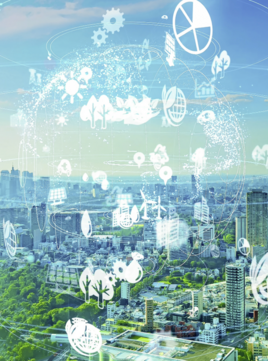Electric, hydrogen and battery
The Technical Authority of Network Rail’s System Operator published the Interim Programme Business Case of the Traction Decarbonisation Network Strategy (TDNS) in September 2020.
Building on the work of the Taskforce and RIA (among others), the TDNS identified where different types of low-carbon traction might be most effectively deployed across the GB rail network. Figure 1 (below left) illustrates the suitability of different low-carbon traction options against rail service types.
By applying this approach to the 15,400 single track kilometres (STK) of unelectrified rail network in Britain, the TDNS proposed a split of electrification, battery and hydrogen (Figure 2, above).
Of the 2,300 STKs where “multiple options” could be delivered, operational and economic analysis has identified a further 1,340 STKs of electrification, battery operation over an additional 400 STKs, and hydrogen operation over an additional 400 STKs.
That leaves 260 STKs of infrastructure where no clear decision has yet been made, but a likely technology is identified within the TDNS National Recommendations document. Further work at a local level will be needed to confirm this.
Innovating at pace
Rail is at an exciting point of its journey as an industry. We have a national challenge to deliver a net zero emissions economy by 2050, and rail has committed to playing its part in delivering that target.
For the first time, there are credible options to deliver low-carbon rail services by means other than electrification. The understanding of how to deliver those options on a selective basis, in a manner which achieves the lowest whole life, whole system cost and carbon impact without compromising the ability to deliver services, is evolving fast.
The capability of the preferred non-electrification low-carbon options (hydrogen- and battery-powered trains) is progressing perhaps more rapidly than could have been expected even a few years ago.
This does not make them a substitute for electrification on high-speed, long-distance lines or for most freight routes, but it does offer genuine options for lines and services which play to the strengths of hydrogen and battery trains - the less busy rural lines where the range and speed of hydrogen trains is suitable, and lines with short hop, frequent stop services or lower running speeds where battery trains will be particularly effective.
The Government sees the railway as being an essential and integral part of a low-carbon, end-to-end transport system. DfT’s Transport Decarbonisation Plan consultation document (see Further Reading 9) projects a 60% increase in passenger demand from 2018 to 2050. While this was published pre-COVID-19, it is possible (as we discuss later) that passenger demand in 2050 may still reflect this long-term projection.
The ambition for public transport, including rail, is nevertheless clear: “Public transport and active travel will be the natural first choice for our daily activities. We will use our cars less and be able to rely on a convenient, cost-effective and coherent public transport network.”
The challenges ahead
Notwithstanding the opportunities that are opening up, there are some real challenges we must overcome to achieve rail’s contribution to net zero emissions in 2050. We can group these loosely into four main areas.
■ 1: Electrification is expensive, requires significant infrastructure, and has to be maintained.
We know this already, of course, but we should not allow ourselves to forget this when debating options. Delivering the extent of electrification identified in the TDNS interim business case will require very significant investment consistently applied over 30 years.
It will come as no surprise if we point out that there will be many demands on the public purse as we recover from the COVID-19 pandemic, so expectations as to the quantum and timing of funds for electrification will have to be managed.
■ 2: The profile of rail usage, for passengers in particular, is uncertain. We will discuss the long-term implications in more detail later when we look at the 2050 vision, but it will be essential to understand on a short to medium-term basis - in revenue, funding and patronage terms as the railway recovers.
■ 3: Britain’s railway is a mixed use, passenger-prioritised system. This means that while we can model ideal freight scenarios which may look encouraging for the possible use of hydrogen and battery traction, in practice the picture is (and is likely to remain) very different.
Even on a network where the main line is electrified, freight will be constrained if branch lines, passing loops and sidings are not electrified.
Freight is further limited in its commercially realistic options by the fact that trains on the GB network are length limited. Even if it proves feasible to power freight trains with an additional hydrogen or battery tender, if this removes a revenue-earning vehicle this may render the arrangement unviable.
In addition, at terminals, swapping a locomotive and tender from one end of the train to the other is a different proposition from simply swapping a locomotive. Space limitations on some sites may even render this impossible.
■ 4: While most rail tracks on (or accessible from) the main GB rail network are owned and managed by Network Rail, not all are. These ‘last mile’ sections are often critical elements, particularly for the freight network.
Freight terminals, ports and other facilities may not ever be able to electrify using 25kV AC overhead lines, due to (for example) operating constraints and safety issues.











